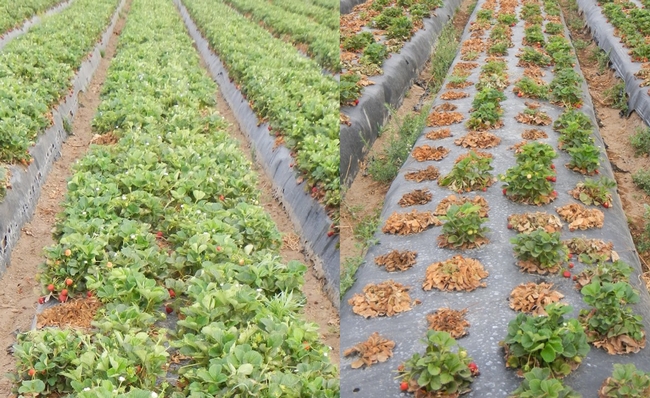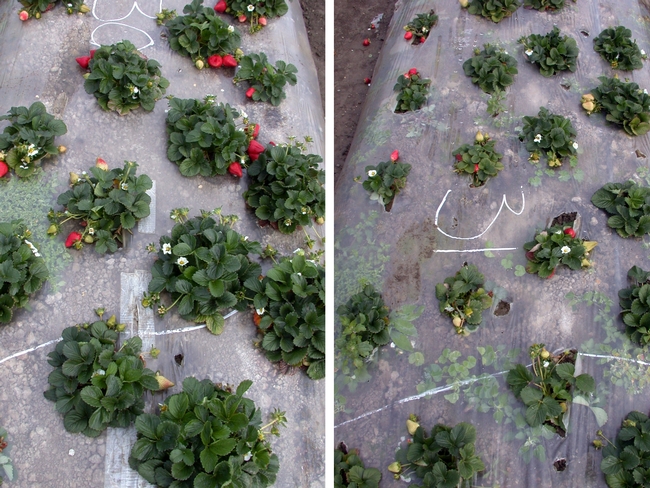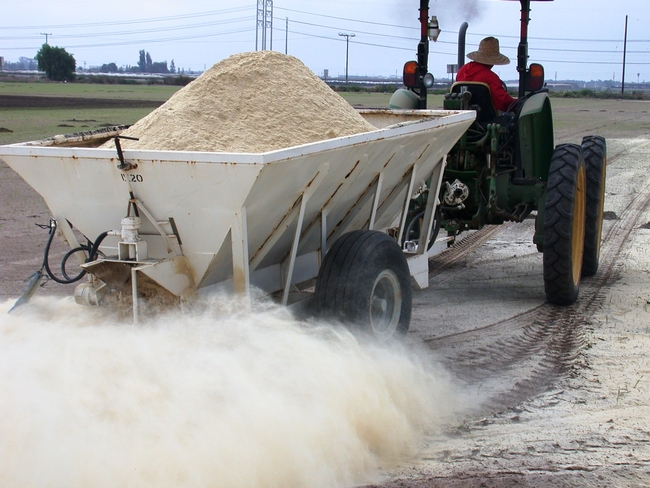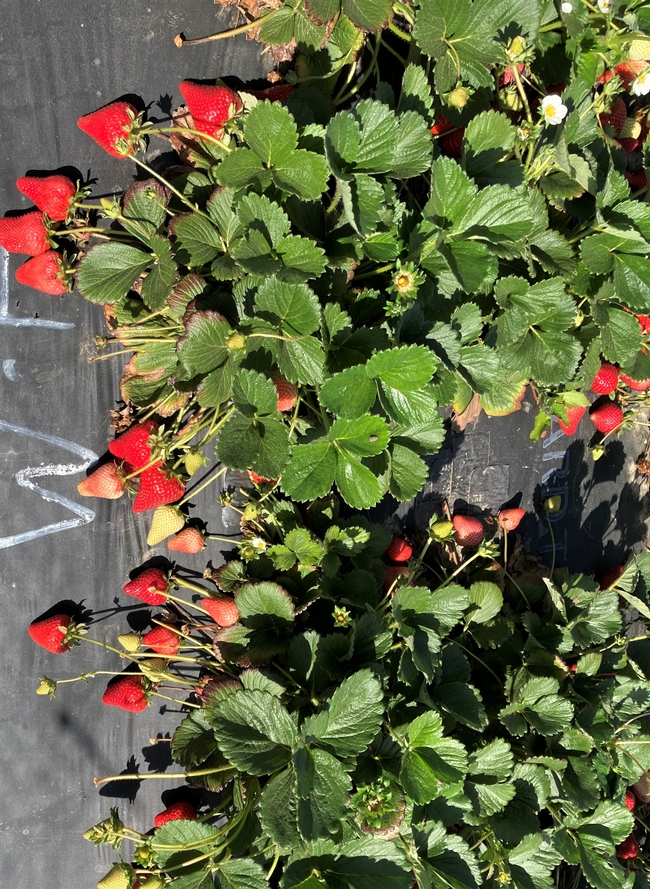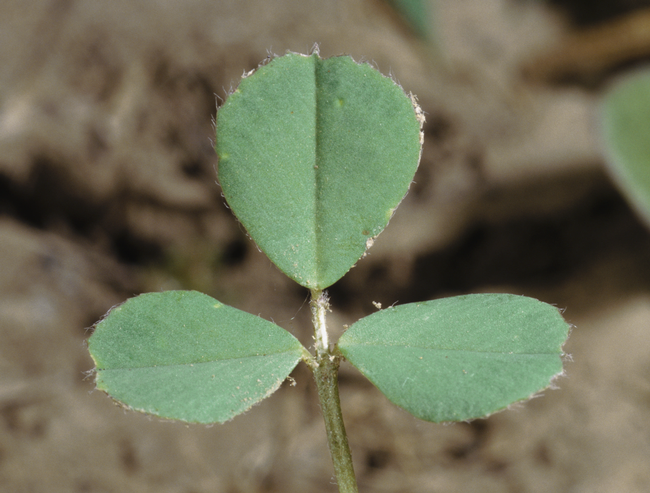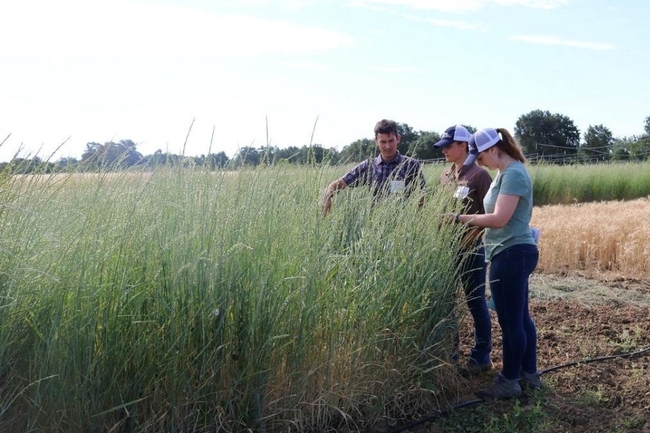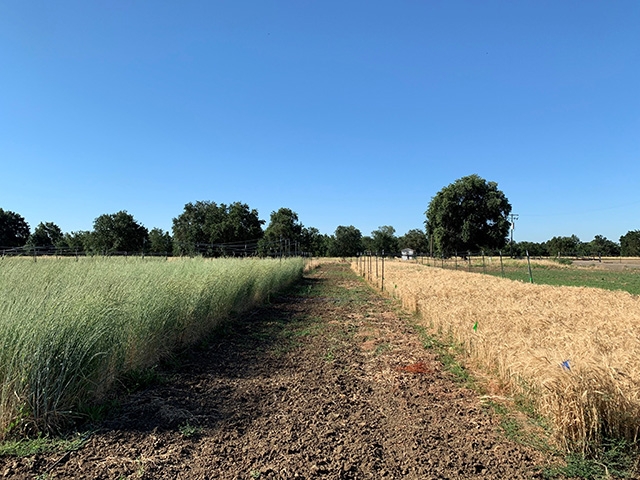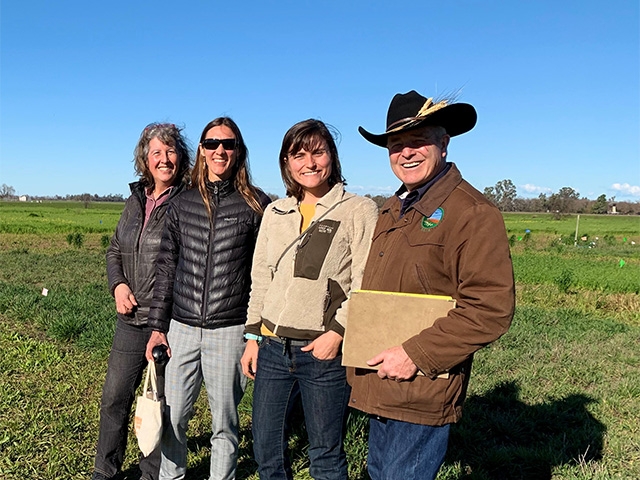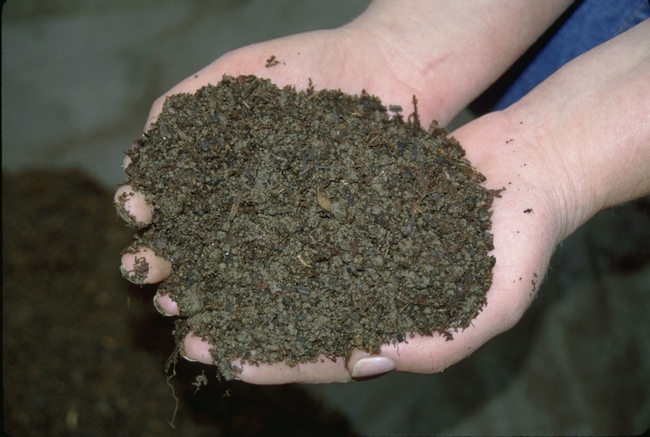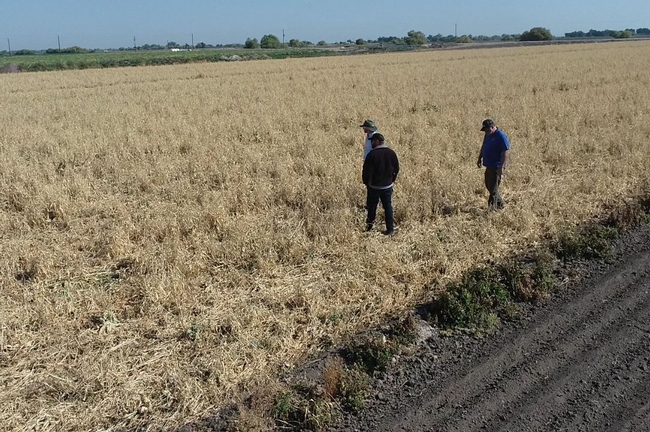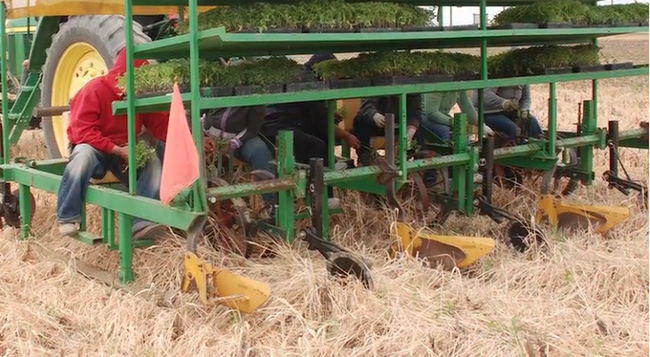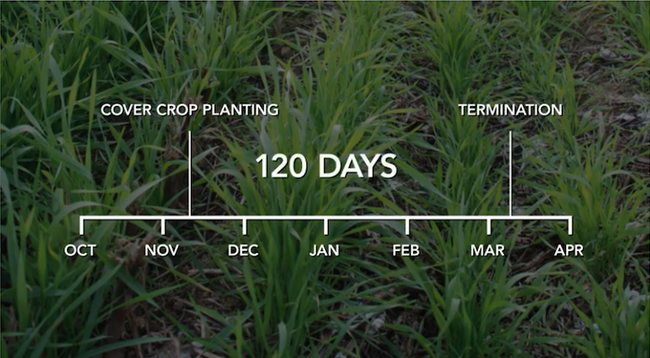Posts Tagged: Soil
Organic strawberry yields boosted by technique refined through UCCE research
Anaerobic soil disinfestation helps suppress weeds, disease without fumigants
Troubled by puny plants, low yields and persistent mite problems, third-generation Southern California strawberry grower Glen Hasegawa was ready to give up on his transition from conventional to organic 12 years ago.
“I've always liked a challenge – but it turned out to be more of a challenge than I thought it would be!” he said.
But then, with the help of scientists including Oleg Daugovish, UC Cooperative Extension strawberry and vegetable crop advisor in Ventura County, Hasegawa tried a technique called anaerobic soil disinfestation (ASD). When applied correctly, the multi-step ASD process creates a soil environment that suppresses pathogens and weeds and makes for healthier, more robust crop growth.
“Back in the day, it was really hard to get the plant growing vigorously in organic,” said Hasegawa, owner of Faria Farms in Oxnard. “So we started using the ASD and then you could definitely see that the plant had more vigor and you could grow a bigger, better plant using it.”
Seeing that he could produce yields “in the neighborhood” of those grown in conventional strawberry fields fumigated with synthetic fumigants, Hasegawa was able to expand his original 10 acres of organic strawberries to 50 acres.
“I guess you could say I'm kind of a convert,” he said, noting that he now applies ASD to all his acreage each year in late spring.
Joji Muramoto, UC Cooperative Extension specialist in organic production based at UC Santa Cruz, has been experimenting with ASD since it was first brought to the U.S. from the Netherlands and Japan in the early 2000s. Carol Shennan, a professor in the Department of Environmental Studies at UCSC, and Muramoto were among the first to try the technique in California. They found that ASD successfully controlled an outbreak of Verticillium wilt – caused by the pathogen Verticillium dahliae – at UCSC's small organic farm in 2002.
Since then, Shennan, Muramoto, Daugovish and their colleagues have seen encouraging results at 10 trial sites across the state.
“We demonstrated that ASD can provide comparable yields with fumigants, in side-by-side replicated trials,” Muramoto said.
ASD promotes host of beneficial changes to soil ecosystem
ASD comprises three basic steps: incorporating a carbon source that is easily digestible by microbes in the soil (traditionally, rice bran has been used), further encouraging fermentation by covering the soil with plastic to limit oxygen supply, and finally adding water through drip irrigation to initiate the “anaerobic” decomposition of the carbon source and maintain the three-week “cooking” process.
The resulting cascade of chemical, microbiological and physical changes to the soil creates an ecosystem that is both conducive to strawberry growth – and inhospitable to pathogens and weeds.
“It's not like a pesticide where you have a mode of action, and thus resulting in ‘A' and ‘B' for you,” Daugovish explained. “There's a sort of cocktail of events that happens in the soil; they all happen interconnectedly.”
Compared to similar fields that did not undergo the process, ASD-applied organic strawberry fields across California have seen yields increase by 60% to 70% – and even doubling in some cases, according to Daugovish.
The UCCE advisor also shared the story of a longtime grower in Ventura County, who came to him with fields in “miserable” condition; they were plagued by one of the world's worst weeds, yellow nutsedge, and infected with charcoal rot, a disease caused by the fungus Macrophomina phaseolina. But after applying rice bran and following the ASD recipe, the grower saw phenomenal results.
“The only complaint he said to me was, ‘Now I have too many berries – we have to have more pickers to pick the berries!'” Daugovish recalled.
Via researchers' meetings, online resources, on-farm demonstration trials and word of mouth from peers, use of ASD by California strawberry growers has grown significantly during the past two decades. Tracking the purchase of rice bran, Muramoto estimated that about 2,500 acres were treated by the ASD-related practices in 2023 – covering roughly half of the 5,200 total acres of organic strawberries in California.
Muramoto directly links the growth of California organic strawberry production – which now comprises about 13% of total strawberry acreage in the state – with the increasing adoption of ASD.
“If you remove the acreage with the applied rice bran over the last 10 years or so, organic strawberry acreage is just flat,” he said.
Within the last decade, acreage of organic strawberries with ASD-related practices increased by 1,640 acres, which is a boon for air quality, human health and long-term soil vitality. According to Muramoto's calculations, that increase in organic acreage translates to a reduction of about 465,000 pounds of fumigant active ingredients that would have been used in growing conventional strawberries.
“There are hundreds of reports of acute illnesses related to fumigation in the record, so it's very important to find alternatives to fumigants,” said Muramoto, citing California Department of Pesticide Regulation documents.
Research continues to make ASD more economical, effective
The popularity of ASD has come at a price, however, for organic strawberry growers.
“There's more organic out there, and I think most of the organic guys are using it, so there's more demand on the rice bran; the price has been steadily going up every year, like everything else,” said Hasegawa, adding that he has been trying to decrease the amount of carbon while maintaining ASD's efficacy.
On top of greater demand from other growers and from beef cattle and dairy producers (who use rice bran as feed), the price also has increased due to higher costs in transporting the material across the state from the Sacramento Valley. So Daugovish and his colleagues – including Peter Henry, a U.S. Department of Agriculture plant pathologist – have been searching for a cheaper alternative.
“We all want an inexpensive, locally available, reliable, easy to use and functional carbon source, which sounds like a big wish list,” Daugovish said.
Carbon sources such as bark, wood chips, or compost are ineffective, as the crucial ASD microorganisms are choosy about their food.
“Microbes are just like cows; you can't feed them straight wood; they get pretty angry,” Daugovish explained. “And if you feed them something with too much nitrogen, they can't digest it – they get the runs. Microbes are the same way – you have to have the right proportion of stuff so they feel comfortable doing what they're doing.”
In search of an ideal replacement, researchers tried and ruled out grass clippings, onion waste, glycerin and coffee grounds. Finally, they pivoted to a material with properties very similar to rice bran: wheat bran, in the form of wheat middlings (also called midds, a byproduct of flour milling) and dried distillers' grain (DDG, a byproduct of ethanol extraction).
After field experiments in Santa Paula, the UC and USDA researchers found that midds and DDG were just as effective at controlling soilborne pathogens and weeds as rice brain – but at 25% to 30% less cost. Their results were published last year in the journal Agronomy.
“Not surprisingly, the wheat bran has worked almost exactly the same as rice bran,” Daugovish said.
He and Muramoto are now conducting trials with wheat bran at commercial fields, and the initial results are promising. Daugovish said the grower at one site in Ventura County has seen a 90% reduction in Macrophomina phaseolina, the causal pathogen of charcoal rot, in the soil – and an 80% to 90% drop in yellow nutsedge germination. They are waiting for final yield numbers after the coming summer.
While ASD has been beneficial to organic productivity and soil health, both Daugovish and Muramoto acknowledged specific limitations in suppressing the “big three” strawberry diseases: Verticillium wilt, Fusarium wilt and charcoal rot. In coastal areas with cooler soil temperatures, for example, ASD can actually exacerbate the latter two diseases, as the fungal pathogens feed on the rice bran.
“We know it works at warmer temperatures, but, practically, it's hard to do in coastal California,” Muramoto said. “It would be nice if we can find a way to suppress Fusarium wilt at a lower temperature, but we don't have it right now.”
That's why researchers emphasize that ASD is not a “silver bullet.” It's just one tool in the organic toolbox, which includes careful crop rotation, disease-resistant strawberry varieties and better diagnostic tests that help growers pinpoint outbreaks and make the application of various methods more targeted and more efficient.
And scientists will continue to optimize ASD to make it more effective and economical for growers in the different strawberry regions of California – from the Central Coast to the Oxnard Plain.
“We know it can work really well; it's just finding the most sustainable way to do this in our region,” Daugovish said. “We've got to just have an open mind and keep trying.”
California Plant and Soil Conference set for Feb. 6-7 in Fresno
The 2024 California Plant and Soil Conference will be held Feb. 6-7 at the DoubleTree Hotel in Fresno. The conference is organized by the California Chapter of the American Society of Agronomy and UC Cooperative Extension.
This year's conference will cover the following topics:
- Are we ready? Adapting agronomy to an uncertain future
- Precision agriculture
- Nutrient management
- Micronutrients
- Animal-plant systems management
- Soil management
- California IPM toolbox
- Pesticide resistance
- Bees, pollinators
- Groundwater recharge
- On-farm water management
“The diverse topics covered at the annual California Plant and Soil Conference are determined by polling members each year about what information is most important for them to learn about regarding sustainable agricultural production in California,” said Nicholas Clark, conference organizer and UC Cooperative Extension farm advisor, who specializes in agronomy and nutrient management.
Growers, pest control advisers and crop consultants, allied ag industry professionals, academics, and government agency staff attend this accessible, science-based conference each year to stay up-to-date on major issues in California agriculture and their potential solutions. In addition to networking opportunities, the conference offers continuing education credits for growers and other ag professionals seeking to maintain various licenses.
“Another really cool thing about this conference is that the chapter has a strong career development component to it,” said Clark. “We support students through financial assistance to attend as poster presenters, and we give monetary awards to student poster contest winners judged by members of the CA ASA board and industry professionals. We also have a merit-based scholarship award given to students each year for their contributions to and potential in the agricultural industry and science fields. These awards are largely supported by private sponsors and member dues.”
The annual conference provides an opportunity for all attendees to increase their knowledge of current topics of agronomic importance in California. By attending the conference, certified crop advisers and pest control advisers can earn continuing education units that are important to their professional standing.
The agenda for the conference includes several new items this year:
- Two additional sessions with six speakers will be offered on the afternoon of Feb. 7 after the business lunch.
- A student-mentor breakfast meeting will be held the morning of Feb. 7 with round-table discussions to hear about mentors' experiences and career paths in agricultural science fields, providing a chance to network and broaden perspectives.
In addition to presentations, there will be an award ceremony to honor individuals who served the profession through their careers, a student poster competition, non-competitive professional posters, and the CA ASA business meeting. Sponsorship opportunities are available to support student participation. For more information, please see the conference website at https://na.eventscloud.com/website/58588/sponsors.
Registration is $375. Early bird registration is $325 and ends Jan. 12. Registration on site will be $425. Register through the conference website: https://na.eventscloud.com/plantandsoilconference.
The conference is planned and presented by a team of volunteer professional agronomists from research institutions, UC Cooperative Extension, public agencies and private companies. If you are interested in serving on the board or have questions about the conference, please contact a current board member (https://na.eventscloud.com/website/58588/leadership).
The California Chapter of the American Society of Agronomy was founded in April 1971 by a group of California agronomists who recognized the value in creating a forum to focus on California agriculture. The purpose of the annual meeting is to promote research, disseminate scientific information, foster high standards of educational and ethical conduct in the profession, and facilitate robust cooperation among organizations with similar missions.
No-till annual wheat better for soil health in California’s climate
One more reason to adopt sustainable cultivation
California wheat farmers could both maintain their yields and improve soil health by growing annual wheat without tilling the soil year after year.
This could be one more encouragement to farmers to adopt a sustainable practice commonly called conservation tillage, no-till or minimum-till cultivation, impacting how we grow a grain that supplies about 20 percent of the calories and protein for people around the world.
A new study, by a team led by Mark Lundy, University of California Cooperative Extension specialist in UC Davis' Department of Plant Sciences, offers new insight for decades-long discussions around soil conservation, sustainable agriculture and climate-warming emissions related to growing our food. The study has been published in the journal Soil and Tillage Research. For the first time, researchers have shown that annual wheat that is not tilled each year is better for stashing carbon in the soil than perennial wheatgrass, while still yielding more crop in Central California.
Previous studies have looked at annual wheat that is tilled each year, annual wheat that is not tilled, and a cousin species, perennial intermediate wheatgrass (trademarked Kernza), which also is not tilled. But until now, no one has looked at all of the benefits and trade-offs together. Most importantly, “no one has ever controlled for tillage,” Lundy said. “And, no one has compared annual wheat to perennial intermediate wheatgrass over multiple years in a Mediterranean climate, which is what we have in California.”
This study also is unique because it delves into the deeper question of what is going on in the soil that drives the different results for carbon there. Soil carbon reflects various processes linked to plant activity and soil health. Measuring the different forms of soil carbon may also signal whether a farming system is accumulating carbon in the soil over time – a plus for reducing climate-warming gases in the atmosphere.
“Measuring soil carbon is complex and nuanced,” said Kalyn Taylor, the lead author on the paper. “We started this experiment because we wanted to know whether and how plant activity and tilling or not tilling would affect the carbon story belowground in California's climate.”
“When we started this study, we thought the crop being perennial or annual would drive the differences in carbon storage in the soil,” Lundy added. Specifically, they had expected perennial wheatgrass would lead to more carbon in the soil because of its deeper, better-established root system. “But that's not what we found,” he went on. “What we found was, it was the lack of tillage, plus the level of productivity of common annual wheat, that made the difference in soil carbon here in California.”
Soil carbon in annual vs. perennial grain
In 2017, Lundy, then-graduate-student Taylor, UC Davis Professor Emeritus Kate Scow and others on the team started measuring different forms of soil carbon in test plots at Russell Ranch, west of campus. Plots were planted with annual wheat that was tilled each spring, annual wheat that was not tilled and perennial intermediate wheatgrass (Kernza) that also was not tilled.
Each year, the researchers measured the carbon present in the soil, the amount of soil organisms (which have carbon in their bodies) and the amount of material the plants created.
At the end of three growing seasons, they found that land planted with no-till, common, annual wheat had the highest amount of soil organisms, measured as biomass, of the three treatments.
The researchers also found soil carbon is more likely to remain stable in the no-till, annual plots, compared to both tilled wheat and wheatgrass.
In addition, the no-till, annual wheat produced plant material more consistently than the perennial wheatgrass across the three years, which saw variation in rainfall.
“Overall, annual wheat grown without soil disturbance or tillage had both higher productivity and higher potential for storing carbon in the topsoil than perennial wheatgrass in our Mediterranean climate,” Lundy said.
Related research
“No-till annual wheat increases plant productivity, soil microbial biomass, and soil carbon stabilization relative to intermediate wheatgrass in a Mediterranean climate,” is online now and will be published in the January 2024 edition of Soil and Tillage Research.
The team also found that tilled annual wheat vs. Kernza stores total carbon at different depths in the soil profile and hosts distinct soil fungal communities, primarily in the root zone and topsoil: Taylor, K., Samaddar, S., Schmidt, R., Lundy, M. and Scow, K., 2023. Soil carbon storage and compositional responses of soil microbial communities under perennial grain IWG vs. annual wheat. Soil Biology and Biochemistry, p.109111.
Previous work comparing the perennial grain known as intermediate wheatgrass (trademarked Kernza) to annual wheat had not distinguished the extent to which soil health benefits are a function of the perennial nature of the crop. Read the story here.
This story was originally published on the UC Davis News site.
Celebrate Healthy Soils Week with free events Dec. 5-9
California Healthy Soils Week 2022 kicks off Dec. 5 on United Nations' World Soil Day. UC Agriculture and Natural Resources is joining the California Department of Food and Agriculture and other organizations in highlighting the benefits of soil health and biodiversity.
During the week of Dec. 5-9, CDFA will present a biodiversity webinar, the UC Master Gardener Program will host two Facebook LIVE webinars and UC Cooperative Extension will co-host a Sustainable Nutrient Management & Soil Health Field Day in Salinas. Details about the free events are below.
Monday, Dec. 5 at 10 a.m.
WEBINAR: Building Belowground Biodiversity CDFA Secretary Karen Ross and members of the Belowground Biodiversity Advisory Committee – composed of world-renowned scientists – discuss how soil biodiversity may impact soil health. The BBAC is tasked with preparing a report of their recommendations on biodiversity indicators as a proxy of soil health and ecosystem functions. This webinar will discuss the importance and impact of belowground biodiversity on soil health and presenters will also share some of their research findings. Register at https://us02web.zoom.us/webinar/register/WN_Jy4iuXb4TyydYcLXTcfThw.
Tuesday, Dec. 6 at 10 a.m.
Healthy Soil: In nature sometimes less is more. Understanding the nature and composition of soil is the first step in our understanding of how to achieve sustainable, healthy soil in our gardens. Mike Corby, UC Master Gardener volunteer in Contra Costa County, will give tips for improving soil health in the garden. To join this 30-minute UC Master Gardener Program LIVE on Facebook, go to https://fb.me/e/4tavSVutB on Dec. 6 at 10 a.m. No registration is required. A recording of the webinar is published on YouTube at https://youtu.be/Y9M5uQtzLyk.
Wednesday, Dec. 7, at 10 a.m.
Harnessing the Magic of the Soil Food Web: Turning Dirt into Gold. Soil is the foundation for life providing habitat, recycling wastes and toxins, providing structural and nutritional support for plants. Over the past 150 years, more industrial practices have replaced natural methods that degrade soil structure and degrade populations of soil organisms, weakening the natural control of soil borne diseases and pests. This has contributed to a reliance on the use of chemical fertilizers, insecticides and herbicides. These chemicals not only affect the soil, but the biodiversity of organisms that rely on the soil and the plants that grow in it. Nurturing soil is one of the best things you can do as a gardener. Plants thrive in soil that is teeming with life.
Kit Veerkamp, UC Master Gardener volunteer in El Dorado County, will discuss why this really matters and how to modify your soils to improve plant health and reduce disease and pests. To join this 30-minute UC Master Gardener Program LIVE on Facebook, go to https://fb.me/e/4VJE3wZA1 Dec. 7, at 10 a.m. No registration is required. A recording of the webinar is published on YouTube at https://youtu.be/Hqd-XDy81H0.
Wednesday, Dec. 7, at 11 a.m.
Web Soil Survey Presentation: Hosted by California Natural Resources Conservation Service, the Web Soil Survey provides soil data and information produced by the National Cooperative Soil Survey. It is operated by the USDA Natural Resources Conservation Service (NRCS) and provides access to the largest natural resource information system in the world. NRCS has soil maps and data available online for more than 95% of the nation's counties. Moderated and presented by Phil Smith, California NRCS area resource soil scientist, and Tony Rolfes, California state soil scientist. This is a presentation on Web Soil Survey and other soil web tools for gathering soils information and maps. Register here.
Friday, Dec. 9, at 9 a.m.
Sustainable Nutrient Management & Soil Health Field Day will be held from 9 a.m. to 3 p.m. at the Agricultural Center Conference Room at 1432 Abbott St. in Salinas.
Presentations will include
- Climate-smart nutrient management for cool-season vegetable crop production by Cole Smith, UC Cooperative Extension staff research associate.
- Co-composted biochar application in intensive vegetable rotation: On-farm trial review by Laura Murphy and Sacha Lozano, Monterey and Santa Cruz Resource Conservation Districts
- Latest developments in measuring soil health: The 4 most responsive indicators by Meagan Hynes, California State University - Monterey Bay
- Healthy soil incentives and Ag. Order 4.0 requirements by Monica Barricarte and Claire Bjork, Central Coast Water Board
- Avenues for improving nitrogen cycling in vegetable production by Richard Smith, UC Cooperative Extension vegetable crops advisor
- In-field soil health assessment & compost spreader calibration by Jessica Chiartas, UC Davis
Five Certified Crop Adviser nutrient management continuing-education credits have been requested for attending the Sustainable Nutrient Management & Soil Health Field Day. To register or for more information, visit http://ucanr.edu/2022snmfd.
Visit the Healthy Soils Week website to see the full lineup of events and partners. To find more healthy soils information on social media, look for the hashtags #SoilHealth and #HSW2022.
Soil health in California cotton fields explored in video series
Over a century of growing cotton in California, scientists and farmers have learned how to better manage soil health. To share their collective knowledge, they have produced a series of videos about cultivating better soil health in cotton fields.
At its peak cotton production, California harvested as much as 1.6 million acres of cotton in the late 1970s to early 1980s. Due to water shortages, growers harvested less than 200,000 acres of cotton in 2020.
“Although cotton acreage in California has fallen off in recent years, some rather impressive advances in soil health management in San Joaquin Valley cotton production fields have been achieved in the past couple of years,” said Jeff Mitchell, UC Cooperative Extension specialist, who formed the California Conservation Agriculture Systems Innovation Center with growers and production consultants.
In partnership with the Soil Health Institute of Greensboro, NC, the Conservation Agriculture Systems Innovation Center has released a four-video series on soil health in California cotton production systems (YouTube links below).
“The series of four videos chronicles not only the history of advances in soil health management in San Joaquin Valley cotton systems, but also some major progress that stems from both long-term research and very recent farmer and private sector innovation with new production paradigms,” Mitchell said.
“San Joaquin Valley farmers have done some really impressive work in recent years to improve the ways that they care for the soil in their fields,” Mitchell said.
To improve soil health, growers try to minimize soil disturbance, enhance biological diversity, keep living roots in the soil and cover the soil with plants and plant residue. They experimented with no tillage and cover crops. Researchers found that cotton fields using no tillage and cover crops achieved a higher soil aggregate stability score than standard tillage with or without a cover crop and no till without a cover crop. In no-till fields with cover crops, water infiltrated the soil in seconds rather than minutes.
The soil health videos range in length from 10 minutes to 21 minutes.
The history video traces important contributors and breakthroughs during the 100-plus years that cotton has been grown in California.
The second video features progress at improving soil health made by Cary Crum, formerly of California Ag Solutions of Madera now with Agritechnovation, Inc., and cotton farmers he works with in the San Joaquin Valley.
The third video chronicles the goals and findings of the unique 22-year soil research study that has been underway in Five Points as one of the Soil Health Institute's national program of long-term North American soil health study sites. It shows what is possible when the core soil health principles are implemented consistently in the region.
The fourth video on the importance of soil aggregate stability shows how attention to the dedicated soil health management principles can improve soil structure and overall production efficiency.
One important lesson from the study is that growers must be patient, improvements in the soil occur gradually.
“We did not see changes in many soil health properties or indicators during the first eight or actually 10 years of our study,” Mitchell said.
Videos on soil health in California cotton fields:
Soil health management systems for California cotton: A brief history https://youtu.be/7DWIJ_3QIz8
Recent advances in soil health management in California cotton production systems https://youtu.be/tRWk-d9F1I8
Local research base for soil health management in California cotton production systems https://youtu.be/AdqnsicuGYo
Regenerating soil aggregate stability in California cotton production systems https://youtu.be/K2fsvPTmlF0

